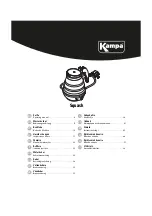
13.
RESERVOIR FILL PROCEDURES
DISTILLED WATER REQUIREMENTS
1.
Ensure kettle is at room temperature
and pressure gauge showing zero
or less pressure.
2.
Remove electrical plug from
power source.
Shut off gas supply to kettle.
3.
Pull Pressure Relief Valve (A) open to insure vessel
is not pressurized.
4.
Remove Pressure Relief Valve (
A
).
5.
Replace Pressure Relief Valve (
A
) with 1/2” Street
Elbow (
B
).
6.
Add distilled or bottled water (
C
)
through the Street Elbow (
B
),
using a funnel if necessary. Fill
the unit to the high level mark on
the Sight Glass.
7.
Apply a thread sealant (i.e. Teflon tape) to the
Pressure Relief Valve's (
A
) thread and replace.
8.
Reconnect gas and electrical supplies.
9.
The kettle must now be vented. (Refer to the
KETTLE VENTING INSTRUCTIONS).
Sight
Glass
50
0
100
150
200
250
300
350
400
40
50
60
0
10
20
30
psi
kPa
V
EN
T
A
IR
A
.
*
Remove Pressure
Relief Valve
B
.
Attach Street
Elbow
C
. Fill unit via 1/2” Street Elbow
*Important
-
Pull ring on Pressure Relief Valve
prior to removal to
insure vessel is not pressurized.
CALIBRATING PROCEDURE
1.
Insure the unit has a vacuum before you begin
calibrating procedures. If unit requires venting refer
to Kettle Venting Instructions.
2.
Turn dial to "
10
" (Max.).
3.
Allow the unit to cycle twice.
4.
Check temperature of the inner kettle surface with a
digital surface thermometer.
5.
Temperature should be between 260° F and 265° F.
6.
Using a screw driver adjust temperature by turning
the potentiometer on the black box. Turn very little.
Turn clockwise to INCREASES and counter-clockwise
to DECREASE temperature.
7.
Allow the unit to cycle twice.
8.
Check temperature of the inner kettle surface with a
digital surface thermometer.
9.
Repeat steps
4.
through
8.
until unit is calibrated.
PRESSURE
RELIEF
VALVE
PERIODIC
TESTING
PROCEDURE
WARNING:
Kettle surface will be hot and steam will be
released during testing. Take necessary precautions
including the use of gloves and eye protection to
prevent personal injury.
1.
With the kettle empty, turn dail to "
10
" (Max.). Allow the
kettle to heat until the unit cycles off.
2.
Turn dial to "
0
" (Off).
3.
Stand to the side of the pressure relief valve discharge
tube and pull valve open for a maximum of one
second. Repeat test three to four times. Each time the
mechanism should move freely and be accompanied
by a rapid escape of steam.
If valve appears to be sticking replace pressure relief valve.
If foreign material is discharged then drain kettle and
replace pressure relief valve.
If Low Water Light comes on after this procedure, you need
to add water to the jacket (see RESERVOIR FILL
PROCEDURE).
KYM APPROVED - MARCH 14, 2011
Kettle
When red “Low Water Light” comes on,
Capacity
add distilled or botttled water.
6 gallon
70 ounces
12 gallon
120 ounces
DANGER:
PRESSURE RELIEF VALVE WILL
EXHAUST HIGH TEMPERATURE STEAM.
CONTACT WITH SKIN COULD RESULT IN
SERIOUS BURNS. KEEP FACE, HANDS
AND BODY CLEAR OF DISCHARGE
.
Summary of Contents for Cleveland KGT12TGB
Page 27: ...26...














































